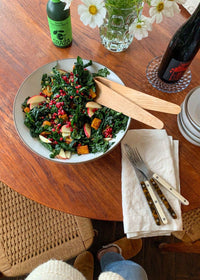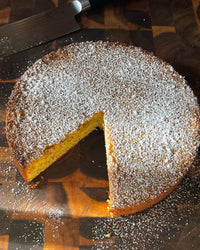
Cooking Hacks with Chef Nick Curtola
The chef behind The Four Horsemen takes us through his trustee cooking hacks including the cheese he always has on hand, making proper polenta, and the only knives you'll ever need.
By Nick Curtola | @nickcurtola
Nick Curtola is the head chef of The Four Horsemen. Raised in Northern California, where he attended culinary school and trained under Camino’s Russell Moore, Curtola would later spend time in Piedmont, Italy, butchering goats and making pasta by hand, before moving to New York. After working at the dearly departed Franny’s, Curtola settled down at The Four Horsemen, where he has been cooking for the last nine years. For more information on The Four Horsemen Cookbook please visit the website here!
October Cooking Hacks
Just Get a Scale Already
Get a scale. Blah blah blah "my grandmother didn't have a scale" blah blah blah. Just get a scale. If it was just for baking alone I'd argue that you have to get one. But it's not. If you want to cook good food consistently, you just need a scale. Five different people will likely measure "1 cup flour" five different ways, yielding totally different amounts. With weight, there's simply less room for error.
Root for the Underdog
We are known for our salads at The Four Horsemen. Can you guess the main ingredient in our most famous one––the salad that people will literally walk up to the kitchen pass and rave about? Probably not, because it is celery. The dish is an unassuming combination of sliced celery, toasted walnuts, Medjool dates, and Piave Vecchio cheese. It's one of many examples at our restaurant, and in our book, of how humble or kind of overlooked ingredients can often do incredible things. Another favorite: lentils.
Keep the Comté Close By
Comté, elegant and compelling while complementing so many flavors, is the ultimate cheese to have up your sleeve. Made in the Franche-Comté region in eastern France, this Alpine-style cow's milk cheese is the perfect match for the oxidized, nutty vin jaune wines of the Jura. Comté never fails, needing little more than a few toasted nuts to heighten its sweet and grassy notes. Walnuts are the classic choice, but I also really love a scattered handful of hazelnuts.
Let Your Meats Rest
Resting a piece of meat after it cooks is as important as the cooking itself. All the care and attention that goes into roasting a beautiful bone-in rib eye can get thrown out the window if it’s left sitting on the hot roasting pan. After it’s cooked, we always rest meat on a room-temperature wire rack placed on top of a room-temperature sheet pan. Doesn’t matter if it’s grilled, pan-seared, or baked. Don’t worry about your hard work getting cold. Most cuts of meat are dense and, once removed from the heat, can even continue cooking for a while before they even begin to cool (it’s called “carryover cooking”). If you slice into a cut of meat too early in the carryover process, all the juices will come pouring out. Don’t rush it.
The Beauty of Blistered Tomatoes
Take some sliced garlic and sauté until fragrant. Add some ground pepper and dry white wine, let the smell of alcohol burn off, and then add some crushed Sungolds. Lower the heat, add butter, and cook until the sauce has a nice sheen from the butter. I find that this simple sauce goes well with everything, from chicken Milanese to grilled bread with slabs of mozz.
Proper Polenta
There’s a super simple dish of polenta with puréed squash and germinate in our book that I am very proud of. The key: the polenta is stone-ground, not instant. I totally get the appeal of anything that saves you 2 to 3 hours o cooking times, but you just won’t get that irresistible springy al dente and perfectly toasty corn flavor any other way.
Age Your Wines. Thank Us Later.
Just a few months can allow a wine to settle into itself, relax, and develop into something much more than it was when you brought it home from the shop. The Four Horsemen has off-site wine storage where we send bottles that we think will be better with time; it almost always pays off. You can easily do the same at home. It doesn't matter if you don't have a EuroCave. Some of us have stashes wines in the crispers of our fridges for a couple of months. Other "storage facilities" in the home include under the bed, at the bottom of a closet, and in the basement. Put the wines there and then forget about them.
Always Be Tasting
Even if you don't know what you are tasting for, taste. Then taste again. Try your best to identify what you are experiencing. This is how you'll learn the differences between bitter, salty, sweet, and savory, and how those flavors are brought about by different flavors and techniques. The more you taste, the more you'll be in command of your cooking. That Meyer lemon pasta? Taste it before and after you add the lemon. What did it do to the dish? Did you add too much? Too little? If you went overboard what can you do now to offset your heavy hand? Would a little butter help mute the acidity?
Don't Be Fooled by the Fancy Knife Set
Please don't bother buying a shiny, ten-piece knife set in a wooden block for $1,000. Just buy three good knives that fit well in your hand: a pairing/petty knife, a chef's knife, and a serrated brea knife. Korin has a beautiful store here in New York, as well as online. Bernal Cutlery in San Francisco and Japanese Knife Imports in Los Angeles are also great resources.
Embrace the Holy Trinity of Vinegars
Champagne for brightness and a sweetness that is not cloying––it's our workhorse at the restaurant. Red wine with some oak age, which softens the inherent sharpness and adds character. And cider for whenever you want an extra layer of bright sweetness, especially with winter produce like bitter chicories.
It's Better From a Bowl
No other plateware can have such an impact on the eating experience as a bowl. A bowl can be a vehicle for a super clear and salty broth, packed with rich gelatin, a few satisfyingly cheesy tortellini floating around, waiting. Or maybe you have a bowl of fresh rice, topped with sticky glazed eel, its smoky juice working their way to the bottom on the journey to your table. The rice starts all dry and springy, distinct from the eel. By the end, each grain is coated in the sweet and savory sauce, and you end up with a whole new set of textures and flavors. The point is love bowls.
Learn to Love "PJs"
New hires sometimes give me a bemused look the first time they hear it: What are precious juices? Nothing more than the excess liquid you would be foolish to discard after making certain recipes. Here's what I am referring to: If you marinate a salad or cucumbers, squid, onions, and coriander berries, they exude liquid as they sit together, and all those flavors mingle at the bottom of the bowl to form PJs––don't leave a drop behind. The golden drippings in the pan below the rack the gorgeous chicken was just roasted on? Get that into a pot of simmering beans, or even back onto the chicken once you've carved it. Same goes for the macerated goodness you get from roasting stone fruit, berries, and grapes; the excess liquid left in bones slowly simmered in a stock, which you can extract with one last nudge through the colander; and the collagen from roasting Dover sole or turbot, just waiting for someone to help it emulsify with the fish's own juices to create an extraordinarily elegant sauce.

















